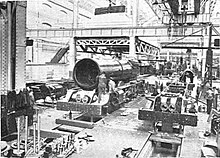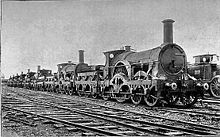Swindon Railway Works
The Swindon railway works were from 1841 the central workshop and later locomotive factory of the Great Western Railway (GWR) in Swindon , County of Wiltshire in England .
history
Occasion and initiative
For the Great Western Railway, its chief engineer Isambard Kingdom Brunel initially procured individual locomotives from various manufacturers from 1836 onwards , but these often did not meet his requirements. In 1837, for example, Brunel hired the young mechanic Daniel Gooch with the task of rectifying the situation. As a first result it became obvious that the GWR needed a central repair shop.
When looking for a suitable location, Gooch considered the branching off of the London - Bristol and London - Cheltenham lines , near which Swindon was located. In addition, the Wilts and Berks Canal located there enabled a direct connection with the Somerset coal field. He also considered that in Swindon for the steeper route to Bristol, the lighter locomotives on the London-Swindon section had to be replaced with more powerful ones. Thus, there was both a special need and an opportunity to supply the machines at this point.
A popular legend claims that Brunel and Gooch made an exit into the valley north of Swindon Hill and that Brunel threw either a stone or a sandwich into the air and determined the place of impact as the construction site.
Gooch said retrospectively, "I was asked to find the best possible location for the workshops and consciously chose Swindon on the junction of the Cheltenham Line, which allows for a convenient division of the Great Western Line's operations. Mr. Brunel and I toured the area in the there were only green meadows and he agreed with me that this was the most suitable place "
With Brunel's support, Gooch submitted the proposal to build the workshop to the GWR board of directors, which approved it on February 25, 1841. Construction began immediately and operations began on January 2, 1843.
Early years
The first locomotive repair shed was completed by contractors in 1841 and the machinery was provided by 1842. With a workforce of 200 men, the first overhaul work began in 1843.
In 1846 a locomotive was built in-house for the first time. The new "Premier" class with the "C" wheel arrangement was built in less than two weeks . Other series followed, including the Iron Duke Class , whose "Lord of the Isles" was the fastest broad gauge locomotive at the time .
As a result, the railway workshops transformed Swindon from a small market town into a bustling railway town , caused a considerable increase in the population and also provided medical and school facilities that were badly missed until then.
In 1851 the workshops employed over 2000 workers and produced a new locomotive every week, including standard gauge locomotives from 1855 onwards. A rolling facility for rails attracted additional workers from south Wales .
In addition to locomotive construction, standardized freight cars were produced from 1850 and from 1867 Swindon became the central workshop for the construction of the rolling stock. The first royal saloon car was built in 1874. In 1878 a separate wagon factory was built north of the station. While other vehicles were also produced at plants in Wolverhampton , Worcester and Saltney near Chester , most production was concentrated in Swindon. In 1875, production facilities for boilers and tenders were built, in which ship engines were occasionally produced for the GWR fleet.
When the GWR decided in 1892 to abandon the broad gauge in favor of the standard gauge, all of the gauge changes were made in Swindon, with vehicles that could not be rescheduled being scrapped.
In 1939 Swindon's population had grown to 61,000 and increased remarkably during World War II. At that time, more than half of the male population worked in the GWR workshops. Swindon was almost entirely dependent on the Swindon railway works for its survivability and further development.
Decline and closure
In 1947, 60 new locomotives were still being produced in Swindon per year, but this rate had been reduced to 42 per year by 1954, a total of around 200 locomotives were built between 1949 and 1960.
1962 ended the locomotive construction in Swindon, only a repair shop was continued. The operation was finally closed in 1986, only one building now houses the Swindon Steam Railway Museum
Superintendents and chief engineers
- Sir Daniel Gooch , Locomotive, Carriage and Wagon Superintendent 1837–1864
- Joseph Armstrong, Locomotive, Carriage and Wagon Superintendent 1864–1877
- William Dean, Locomotive, Carriage and Wagon Superintendent 1877–1902
- George Jackson Churchward , Locomotive, Carriage and Wagon Superintendent 1902-1916, Chief Mechanical Engineer 1916-1921
- Charles Benjamin Collett , Chief Mechanical Engineer 1921-1941
- FW Hawksworth, Chief Mechanical Engineer 1941-1949
Individual evidence
- ↑ The World's Finest Railway Works ( Memento of the original from September 22, 2005 in the Internet Archive ) Info: The archive link was inserted automatically and has not yet been checked. Please check the original and archive link according to the instructions and then remove this notice. , SwindonWeb on December 6, 2006
- ^ British History Online
literature
- Alfred Williams: Life in a Railway Factory, 1915, Duckworth, London, ISBN 978-0-905778-31-0
- Mark Child, Swindon: An Illustrated History, 2002, Breedon Books Publishing, United Kingdom, ISBN 1-85983-322-5
- Swindon Works, and its Place in British Railway History, Railway Executive (Western Region), London
- The Railway in Town and Country, 1986, David and Charles, Newton Abbott
- The Railway Workshops of Great Britain 1823-1986, EJ Larkin, 1988, Macmillan Press
- Swindon: the Legacy of a Railway Town, John Cattell; Keith Falconer, 1995, HMSO, London





